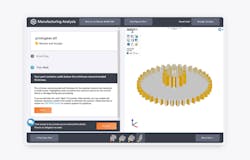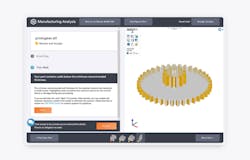Automated Design Feedback Tool for 3D-Printed Parts
Product developers and engineers make quick work of product designs when they access a manufacturability analysis tool from Protolabs.
Protolab’s design for additive manufacturability (DfAM) analysis tool is an optimization suite that is integrated with its quoting platform. The tool provides automated feedback that enable users to fine-tune additive designs before parts are printed. The process accelerates product development and is touted for reducing costs associated with engineering complex parts, thereby avoiding unnecessary production costs.
“Protolabs was one of the first digital manufacturing companies to launch automated manufacturability analysis on molded and machined parts—a tool that quickly became essential for our customers during their iterative design process,” said Oleg Ryaboy, chief technology officer, Protolabs. “We’re excited to expand our design for manufacturability suite into 3D printing so customers can take advantage of the same speed and cost-reduction benefits.”
Read More: How Design for Excellence (DfX) Intersects with Rapid Prototyping
More Benefits with DfAM Analysis
The objective of DfAM is to minimize risk of errors when creating a part or tool. The DfAM method and process optimizes performance and function at the design phase. In additive manufacturing applications, DfAM exploits key traits that are endemic to 3D printing, such as wall thickness, shrinkage, part orientation, overhangs and layer height.
Further benefits associated with using the DfAM process are:
- Additive manufacturing is a digital process, which aligns with advanced engineering and automation tools.
- Increased complexity in design does not translate to increased costs.
- Mass customization and tooling is more accessible, as producing components with slight variations in design don’t significantly affect the price.
Read More: A Peek Inside Proto Labs’ 3D-Printing Facility
A Single Manufacturing Source
Protolabs noted that DfAM analysis is available globally on parts uploaded online at protolabs.com for any of the company’s plastic and metal 3D printing technologies. When design engineers receive their quotes, the analysis highlights potential manufacturability advisories concerning thin walls, small gaps and parts that exceed maximum size restrictions.
The company noted that the digital toolkit can produce low-volume parts within days, while their digital network of manufacturing partners, powered by Hubs, open up advanced capabilities and volume pricing at higher quantities.
About the Author

Rehana Begg
Editor-in-Chief, Machine Design
As Machine Design’s content lead, Rehana Begg is tasked with elevating the voice of the design and multi-disciplinary engineer in the face of digital transformation and engineering innovation. Begg has more than 24 years of editorial experience and has spent the past decade in the trenches of industrial manufacturing, focusing on new technologies, manufacturing innovation and business. Her B2B career has taken her from corporate boardrooms to plant floors and underground mining stopes, covering everything from automation & IIoT, robotics, mechanical design and additive manufacturing to plant operations, maintenance, reliability and continuous improvement. Begg holds an MBA, a Master of Journalism degree, and a BA (Hons.) in Political Science. She is committed to lifelong learning and feeds her passion for innovation in publishing, transparent science and clear communication by attending relevant conferences and seminars/workshops.
Follow Rehana Begg via the following social media handles:
X: @rehanabegg
LinkedIn: @rehanabegg and @MachineDesign

